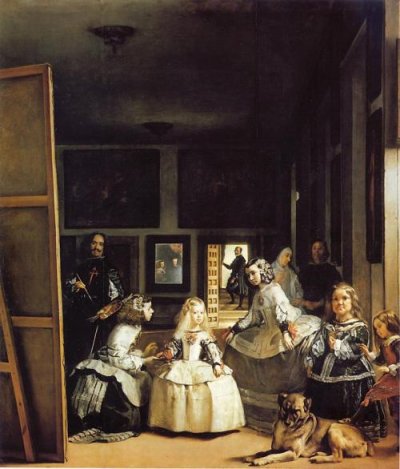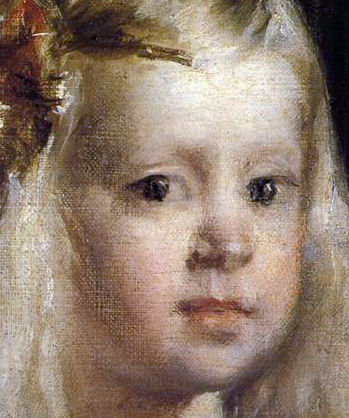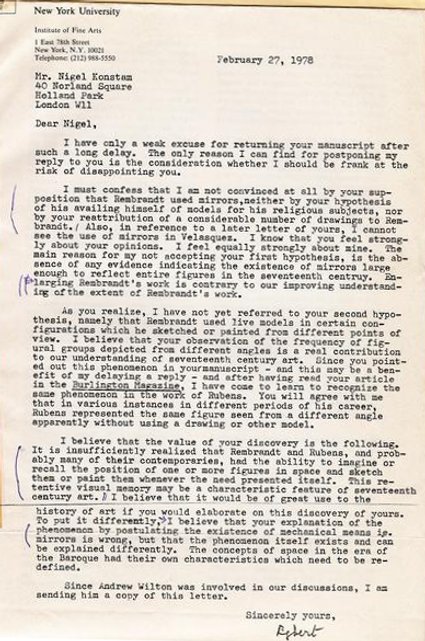
Las Meninas
Las Meninas (1656) is Velasquez’ masterpiece. It is also his most complicated composition but was apparently achieved very quickly without his usual after-thoughts. The paint is remarkably thin, with little over-painting and applied with his usual breadth of handling. Surprisingly out of character for a painter aged fifty six. It needs some explanation. I explained it very simply in an article in The Artist Magazine (Mar 1980) and in a lecture at the Slade at about that time. I also exhibited the model with which I reconstructed the method in the Consort Gallery, Imperial College in that year.
RECONSTRUCTION On the left we see Velasquez at his canvas. A painted self-portrait also often includes the back of the canvas we are looking at, the only difference between this and the usual canvas is that this canvas is very tall. Las Meninas is 10ft, 3.18m tall. A self-portrait requires a mirror. All the other figures appear to be observed in the same mirror. It is surely worth asking the question did Velasquez actually use a mirror. R.Willenski asked that question, and answered yes, but no other art historian seems to have paid the slightest attention. I was initially stimulated to make my own inquiry by reviewing a book “Velasquez. The Art of Painting” devoted to this work, by M.Millner Kahn. Her explanation is so long and tortuous I cannot summarize a whole book.
I agree with Willenski; there are eight good reasons for doing so
1. X-rays show that Velasquez first painted himself as a left-hander and later changed it to conform with reality.
2. He painted the Infanta in the same year but with her parting on the other side of her head. (another mirror reversal)
3. The light comes from the window on the right, it hits the people on the right directly as you would expect but for the Infanta and the people on the left there is also a “fill light” that has bounced off the mirror. See how it illuminates the back of the canvas although the canvas is slanted to receive direct light on the front. Note the cast shadow on the floor.) The mirror is the picture plane between us and the picture. It allows Velasquez to arrange his models within the framed picture space as a photographer might do.
4. All the players look as if they are admiring the Infanta’s reflection in the mirror. The mirror is now at ground level, this may be the first time the Infanta has seen herself in it.
5. The size of the images in the painting are compatible with the idea that Velasquez actually traced their outline on the mirror surface, which he then transferred to his canvas. This would go a long way towards explaining the speed and sureness of the painting’s execution.
6. Velasquez previous work does not suggest an interest in geometric construction or defined interiors, rather the opposite.
7. Until recent times this painting was always exhibited opposite a mirror!
8. Do you see the blob of paint beside the Infanta’s nostril? That confirms the existence of the horizontal support bar we see on the back of the canvas. As the loaded brush hits this ridge it deposits more paint.

Infanta Margarita
I have been looking at Martin Kemp’s explanation of this painting in “The Science of Art” (Yale, 1990) . Kemp draws a ground plan that does not remotely resemble the room we see. It is far too long and narrow (it cannot even contain the width of the canvas he draws). He does not explain the method but tells us that Velasquez’ painting is “a declaration of his supreme gifts as a magician of painterly illusion”. I identified the room as the Pieza Ocbavada, which was more or less square in ground plan (the near ceiling fixture is its real centre; the other fixture is faked.). This room was next door to the Hall of Mirrors. It is no coincidence, in my view, that Velasquez was occupied with the redecoration of the Hall of Mirrors at the time he painted Las Meninas. It seems highly likely that he moved the great mirror next door to save it from possible damage and there conceived the idea of making a picture of the same size to hang opposite it. It may even be that the Infanta and her entourage composed themselves to some extent in front of this marvel (probably the largest composite mirror the world had ever known: over 8ft wide but lost in the fire of 1734)
It is a long established rule in science that the simplest explanation is likely to be the correct one. Why is it that art historians prefer explanations that are so complicated that they have only the vaguest idea of how they could work. Certainly both the hypotheses mentioned above would tie most practicing painters in knots.
My explanation ( Willenski never pursued the idea) could be very useful to a painter who had a complex group portrait to do. There is every reason to believe that both Goya and Velasquez’ assistant knew and used the method as does Ken Howard in our own day.
CREDITING GENIUS WITH THE IMPOSSIBLE obviously appeals to the earthlings longing for the miraculous. Like Velasquez’ “magician’s” achievement here, Kemp’s preferred methods for Brunelleschi’s invention of modern perspective are all beyond explanation, only his least favourite – (f) in his appendix, can produce the goods. This easy acceptance of the miraculous is a consistent failing of Art Historians. Kemp’s preferred solutions show he does not even grasp the problem and therefore cannot recognize the solution. They all put the cart before the horse: the geometry before the image. His scorned solution(f) does work, so would Hockney’s solution but Hockney has not read Manetti.(see “Brunelleschi’s Perspective” in this blog)
After the publication of my entirely practical explanation of Rembrandt’s quirky production as a draughtsman (Burlington Feb. 1977) which corroborated the reports of Rembrandt’s contemporaries (that he was an inspired observer not an inventor) I visited both Harvard and Yale in search of a publisher for my book on Rembrandt. At Harvard I lectured to the Rembrandt specialists (professors and post-graduate students) The result was a storm of questions. I heard afterwards (at Smith) that the Harvard gang admired my footwork in answering.
AN EXAMPLE
HG “In the 17th c they did not even need still-life in front of them to paint from.”
NK “ What makes you think that”
HG “ Flower painters often painted blooms together that were not in season together”
NK “well flowers wilt, flower painters tend to pick and paint their specimens one at a time”
HG stunned silence.
Although the majority of the audience, I presume, went on to teach and publish on Rembrandt I never received any further communication from any. At the reception afterwards the only people present were myself and the student in charge of the wine. He valiantly tried to convert me to the Harvard view, which has deteriorated still further since then.(see review of the Getty catalogue.)
At Yale I was able to discuss my findings with Prof. Haverkamp Begermann for well over an hour during which time he was unable to advance a single objection to my view. Optimistically I left the typescript of my book with him. After a year, I inquired of it’s progress and it was returned with the accompanying letter which contains the hilarious idea that I had discovered the three dimensional nature of the 17thC imagination! He advised me to write a book about that!

This kind of "thinking" has all but destroyed Rembrandt, the patron saint of the art of observation. Is it not time to wake up to the reality of Art History?
Later, my agents packaged the book on the understanding that it had been accepted by Phaidon with the whole editorial behind it, though they fully understood the revolutionary nature of the contents. All they needed was a reader’s report. When that came they dropped the project and ran. I was given an edited version of the report which made my hair stand on end on the first reading but on closer examination it turned out to be a cunningly crafted swindle. I answered the swindle but to no avail. Word got round and none of the nearly 30 publishers approached after Phaidon found the courage to take on the book but doubtless many experts got a chance for a good look at it. Lawrence Gowing in his review of Svetlana Alpers’ “Rembrandt’s Enterprise” (TLS Dec 16 ‘88) chided “more discussion of the sculptor Nigel Konstam’s observations on Rembrandt’s use of enactments and reflections would not have been out of place”!
Since those days I have done my best to propagate the true Rembrandt with three news-sheets “The Save Rembrandt Campaigner”(to counter the three exhibitions of Rembrandt and his Workshop, in Berlin, Amsterdam and London) with films, shows and DVDs, a website www.saveRembrandt.org.uk and this blog. Most of what I have to say is well within the competence of an educated person. It needs no specialist training in art. All you need is the confidence in your own common sense to see through the bullshit from on high. Our visual culture will be stuck in the mire until some group can muster the momentum to push over the deceitful house-of-cards that is art history. My single voice has all too easily been left to cry in the wilderness.
All these examples can be seen and discussed at
THE MUSEUM OF ARTISTS’ SECRETS.A catalogue of the museum could be of great interest, as also the book on Rembrandt.
Centro d’Arte Verrocchio,
via San Michele 16,
Casole d’Elsa
53031 SI, Italy.
appointments tel.no.0039-0577-948312 or email nkonstam@verrocchio.co.uk
PLEASE PRINT OUT THIS NOTICE FOR THE ART HISTORY NOTICE-BOARD OR OTHER SUITABLE PLACES
For the latest news on Brunelleschi's Perspective and Las Meninas see www.verrocchio.co.uk/nkonstam/blog